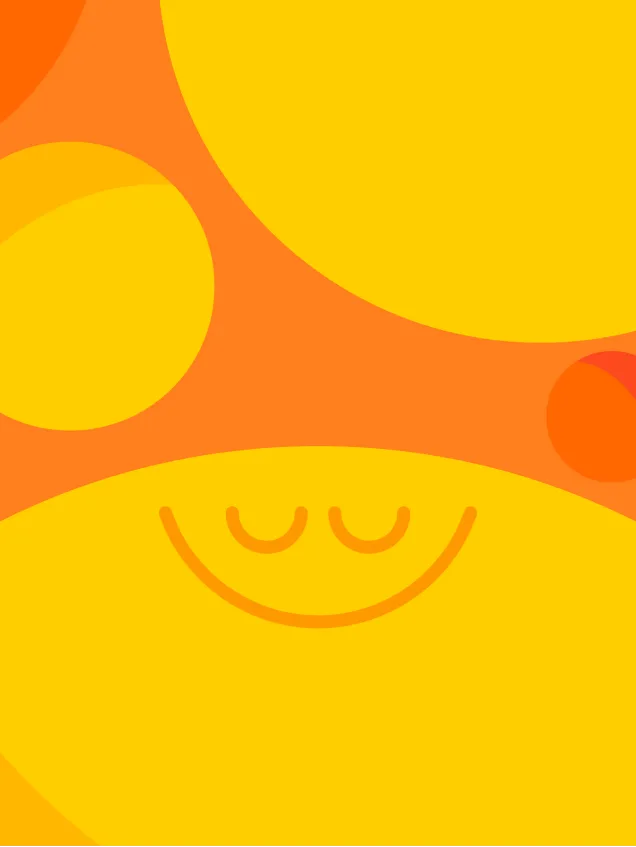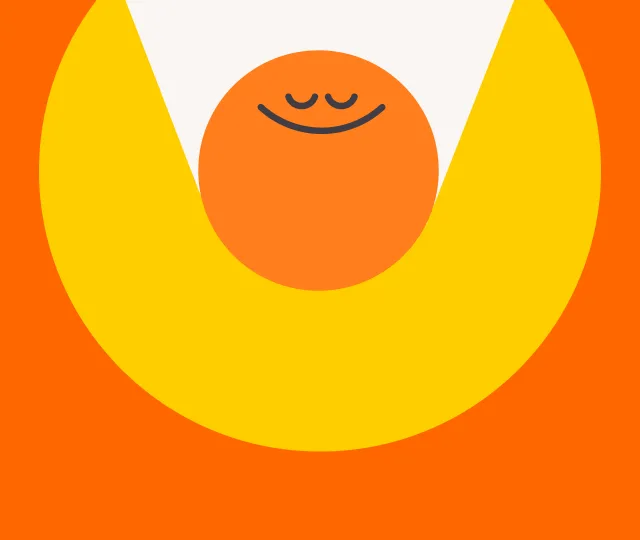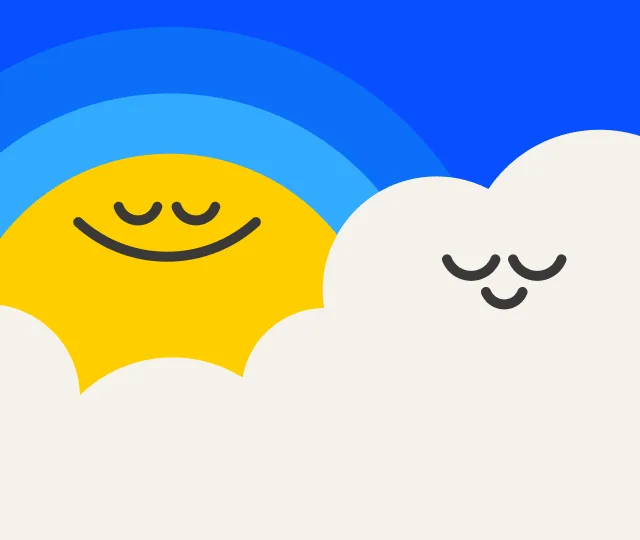Meditation for anxiety
Researched and written by our mindfulness and meditation experts | Learn more
Oct 6, 2021
Anyone who has ever been in the grip of anxiety knows how intense it can be. According to the National Alliance on Mental Illness, an estimated 40 million adults in the U.S. have some kind of anxiety disorder. Worldwide, 1 in 14 people are affected. So if we feel like we’re the only ones dealing with anxiety — and yes, that’s how isolating it can feel — be assured none of us is alone.
We’ve all likely experienced the feeling of anxiety, whether it’s butterflies in the stomach, sweaty palms, heart palpitations, tension headaches, an upset stomach, or tightness in the chest — all natural occurrences when adrenaline is pumping. But there’s a difference between everyday anxiousness and clinical anxiety.

Watch The Hole in the Road
1 min
Feelings of anxiousness versus an anxiety disorder
Our adrenal glands start flaring whenever we’re in a dangerous situation or potential conflict, activating the “fight or flight” mechanism, or when we’re a bag of nerves ahead of delivering a speech, a must-win sports game, or walking down the aisle, for example. That’s anxiousness.
But anxiousness becomes generalized anxiety disorder (GAD) when the fear or worry doesn’t abate, escalating into a sense of impending doom, constant ruminating, catastrophizing, and, in some cases, panic. Anxiety on this scale can be all-consuming, debilitating, and distressing.
Stress can, of course, induce anxiety, and there’s an overlap between the 2 in terms of the physiological reactions. Stress is a heightened emotional state that dissipates once a stressful situation is over whereas GAD is a diagnosable condition that tends to persist for long periods.
Anxiety that becomes a disorder is characterized by a “persistent and excessive worry” where individuals can lose rational perspective and “expect the worst even when there is no apparent reason for concern,” according to the Anxiety and Depression Association of America.
Managing anxiety through meditation
Understanding anxiety is the first step in managing it. In knowing its erratic nature, we can obtain a better sense of triggering situations and how our anxiety operates — and that’s where meditation comes in.
Anxiety is a cognitive state connected to an inability to regulate emotions. But research shows that a consistent meditation practice reprograms neural pathways in the brain and, therefore, improves our ability to regulate emotions.
Through meditation, we familiarize ourselves with anxiety-inducing thoughts and storylines. We learn to see them, sit with them, and let them go. In doing so, we learn 2 important things: thoughts do not define us, and thoughts are not real. Within this newfound perspective, we’re able to gradually change our relationship with anxiety, differentiating between what is an irrational episode and what’s true.
Another benefit of this skill is learning body awareness, which teaches us to bring our attention to any physical sensations felt in the moment. This technique involves mentally scanning the body, inch by inch, making us more attuned to what’s being experienced physically. In exploring these sensations, we sit with our senses in the same way we sit with your thoughts. This go-to technique can provide a safe place that can be repeatedly accessed whenever anxiety starts to creep in.
Anxiety’s effect on our body
Anxiety has the same effect on our bodies as stress does in that it triggers the autonomic nervous system, leading to a spike in the release of epinephrine and cortisol — the “stress hormones.” Too much epinephrine can increase the risk of heart attacks and strokes; too much cortisol can affect our health in numerous ways — including increasing blood sugar levels, suppressing the immune system, and constricting blood vessels.
When these hormones are released into the bloodstream, the liver produces more glucose, which is what provides the energy to activate our fight-or-flight mechanism, ultimately leading to an increase in blood pressure, heart rate, and cholesterol levels, all of which disrupts our immune system, energy levels, and sleep.
We meditate to counter the “stress response,” leading to a decrease in blood pressure, heart rate, and oxygen consumption. It also creates a more gradual change in the brain, which is where meditation really works its magic, inducing a set of physiological changes) that form the stress-busting “relaxation response” that can be seen in MRI imaging.
The brain’s response
Located deep within the brain’s limbic system are 2 almond-sized nuclei called the amygdala — essentially tiny processing chips that govern our senses, memories, decisions, and moods. When it comes to how we react to life and express ourselves, this is where it all happens. The amygdala is our emotional thermostat.
As with all thermostats, the amygdala is susceptible to certain forces — in this case, anxiety — ranging from a calm, rational, level-headed setting to an over-reactive, anxiety-ridden state. The more anxiety we experience, the more disproportionate and irrational the amygdala’s response. And so, unwittingly, we’re teaching the amygdala to no longer regulate itself.
What’s more, the drip, drip, drip effect of constant anxiety can reshape the structure and neural pathways of the brain — a process called neuroplasticity. The brain gets reprogrammed by the experiences it’s continually subjected to. So it follows, then, that meditation would have an opposite, more beneficial effect.
Studies involving MRI scans show that the amygdala shrinks in response to meditation practice. As the amygdala reduces in size, the prefrontal cortex — the area of the brain governing our awareness — becomes thicker. By meditating, we can increase our capacity to manage anxiety. The more we practice this skill, the more we build this mental resilience.

Types of anxiety disorders
Anxiety disorders are characterized by a general feature of excessive fear (an emotional response to a perceived or real threat) and/or anxiety (worrying about a future threat) and can have negative behavioral and emotional consequences. There are several diagnosable anxiety disorders:
- Generalized anxiety.
Worrying about things in everyday life.
- Social anxiety.
Worrying about being evaluated negatively in social situations.
- Separation anxiety.
Fear of separation from home or a loved one.
- Panic disorder.
Panic attacks that strike without warning in any number of situations.
- Obsessive compulsive disorder.
An obsession or compulsion to repeat certain behaviors or rituals.
Through meditation — and understanding the trickster nature of anxiety and what it does to the mind — we learn to recognize the triggering thoughts. From there, we can work to find different ways around these mental patterns and avoid falling into “the trap” again.
Try 7 meditations for anxiety
Looking for more meditations to feel calmer and less worried? The Headspace app offers subscribers several courses and single meditations on managing anxiety, including:
Cultivate a new perspective on fear.
Use this exercise to create more mental space from worrying about things that haven’t happened yet.
Find a place of stillness by slowly releasing tension, one muscle at a time.
What do we do when anxiety arises during meditation?
Ease your mind by practicing the loving-kindness technique toward yourself and your loved ones.
Create the space for the mind to gently come to rest with this nighttime meditation.
A restorative class with extra attention on the breath, great for getting you back to a more centered, calm mind.
Meditation is one option out of a myriad of treatments available to help people manage, or learn to cope with, feelings of anxiety in a different way, essentially changing the relationship to anxiety, and the way it’s viewed.
Meditation isn’t a quick-fix strategy; it does take a long-term approach. For those who may have severe anxiety, or if have been diagnosed with an anxiety disorder, always speak to a health care professional to talk through options and figure out how to make meditation a component of an overall treatment program.
DISCLAIMER: General meditation practice and apps like Headspace are not a replacement for or a form of therapy nor are they intended to cure, treat, or diagnose medical conditions, such as anxiety disorder. Meditation can, however, be a component of an overall treatment plan when monitored by a healthcare professional.
Key takeaways:
-
Understanding anxiety is the first step in managing it
-
Then, through meditation, we learn to recognize the triggering thoughts and can work to find different ways around these mental patterns
-
Try 7 meditations for anxiety


Be kind to your mind
- Access the full library of 500+ meditations on everything from stress, to resilience, to compassion
- Put your mind to bed with sleep sounds, music, and wind-down exercises
- Make mindfulness a part of your daily routine with tension-releasing workouts, relaxing yoga, Focus music playlists, and more
Annual - billed at null USD/yr
14 days free
null USD/month
Monthly
7 days free
null USD/month


Stay in the loop
Be the first to get updates on our latest content, special offers, and new features.
By signing up, you’re agreeing to receive marketing emails from Headspace. You can unsubscribe at any time. For more details, check out our Privacy Policy.
- © 2025 Headspace Inc.
- Terms & conditions
- Privacy policy
- Consumer Health Data
- Your privacy choices
- CA Privacy Notice






